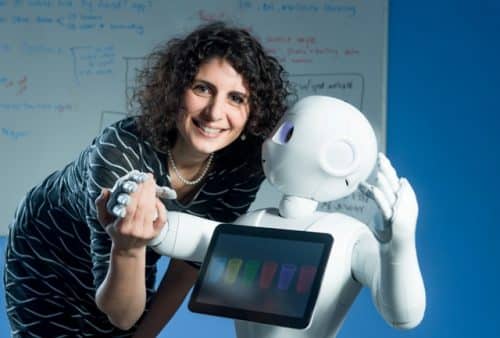Researchers from Ben-Gurion University of the Negev report on preferences in interactions between a robot and a human, and suggest customizing the robot's behavior for each user

In a new study published in the journal Restorative Neurology and Neuroscience, the researchers examined the preferences of the users when they performed a joint movement task with the robot, as a first step towards developing an interactive movement protocol, which will be used as part of a rehabilitation process.
Dr. Sheli Levy-Tzedek, who heads the Cognition, Aging and Rehabilitation Research Laboratory in the Department of Physiotherapy in the Faculty of Health Sciences, and is a member of the Zalotovsky Center for Nerve Research at the university, focused her research on the use of robots for the rehabilitation of patients who need training at home due to a lack of treatment hours with physical therapists. Since most patients do not exercise adequately enough (or at all) at home, she designs interactions with robots that will serve as companions and partners in practice, in order to encourage patients to exercise, monitor their progress, and give feedback to both the patient and the physical therapist.
"In the future, humans may increasingly rely on robotic assistance for daily tasks, and our research shows that the type of movements the robot makes when interacting with humans affects the level of human satisfaction with the interaction." According to Dr. Levy-Tzedek, "Humans feel that if the robots do not move like them, it is confusing, and they will use them less frequently."
In the study, 22 participants in their 20s played a "mirror game" - a game common in improvisational theater. Usually two people participate in the game, one leads with his hand movement, and the other follows with his hand. After that, they switch roles. In Dr. Levy-Tzedek's research, one of the participants was a robotic arm. As in the original mirror game, the participant and the robot each took turns following the partner's movement pattern. When the robotic arm led, it made movements that were sharp, similar to dribbling a ball, or smooth, like marking a circle in the air.
The study yielded three main conclusions: First, people tend to imitate robotic movements. "This is an aspect that is particularly important to take into account, for example, when designing a robot in the role of a hospital nurse, who is supposed to assist the surgeon in the operating room," says Dr. Levy-Tzedek, "we would not want a robot in the role of a nurse that would make sharp "robotic" movements, which would affect the way The surgeon moves her hands during the operation."
Second, there was no clear preference on the part of the participants whether to lead the robot, or to follow it. Half of the group preferred to lead the joint movements of the robot and the human, while the other half preferred to follow them.
Dr. Levy-Tzedek: "This finding emphasizes the importance of developing personalized robot-human interactions. Just as the field of medicine is moving towards personalized medicine for each patient, so in the field of robotics a different pattern of interactions needs to be adapted for each user."
Finally, the study participants preferred smooth and familiar movements, reminiscent of human movement, over sharp (“robotic”) movements or unfamiliar movements, made when the robot led the interaction.
"That's why it's important to understand what motivates the participants to continue, when designing future robots that will socialize with humans on a day-to-day basis," says Dr. Levy-Tzedek.
First results of the research, which was carried out by undergraduate student Shir Kashi, Won the "Best Poster Award" at the Human-Robot Interaction (HRI) conference held in March in Vienna. Kashi graduated with a bachelor's degree in neuroscience at Ben-Gurion University of the Negev, and is now starting her master's degree in the laboratory.
The research was funded by the Lear Foundation, the Bronfman Foundation, the Promobilia Foundation and the Israel Science Foundation. Additional funding was provided by the Helmsley Charitable Foundation through the ABC Robotics initiative and the Marcus Endowment Fund at Ben-Gurion University of the Negev.
See more on the subject on the science website:
- Grandma's robotic assistant
- The future of hospitals, medicine - and the health of all of us
- A new generation of social robots
- Four types of artificial intelligence - from responsive robots to self-aware ones
- An Israeli startup is developing an artificial intelligence-based robot that will improve the lives of senior citizens
